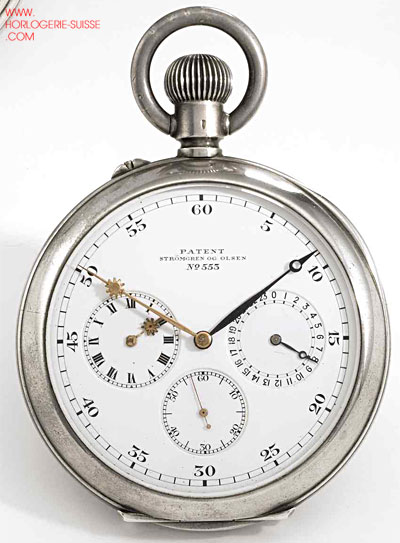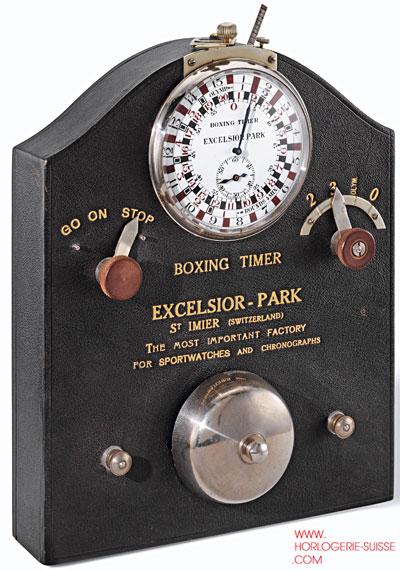

les trésors de christie's
STROMGREN ET OLSEN MONTRE DE POCHE D’OBSERVATION LEPINE ECHAPPEMENT A ANCRE, EN ARGENT REGLEE POUR LE TEMPS SIDERAL ET LE TEMPS MOYEN, SIGNEE STROMGREN OG OLSEN, NO.553, PATENT, BOITE NO.54946, CIRCA 1918
Patentée en 1918 par Svante Elis Stromgren et Jens Olsen, cette montre est réglée pour le temps sidéral et le temps solaire moyen. Elle a été conçue principalement pour la navigation astronomique sur la mer et montre continuellement le temps sidéral et le temps solaire moyen d’un fuseau horaire sélectionné.
Les aiguilles bleues en argent montrent le temps moyen et celles en or le temps sidéral. Seulement trois autres exemples d’une telle montre sont connus à ce jour. Les astronomes se fient aux pendules sidérales parce que n’importe quelle étoile va traverser le même méridien, ou ligne de longitude au même temps sidéral tout au long de l’année.
Le temps sidéral est basé sur le mouvement apparent du point vernal d’une étoile. Chaque jour sidéral est environ 4 minutes plus court qu’un jour solaire et commence au moment où l’équinoxe de printemps traverse le premier méridien. Les astronomes utilisent le temps sidéral pour ajuster le temps moyen parce que son point de référence céleste reste presque figé par rapport aux étoiles. Le temps solaire moyen est basé sur un soleil factice et imaginaire, dont le jour solaire est un 24 heures mathématiquement uniforme. Nos montres ordinaires mesurent le temps moyen. Christie’s Genève 12 novembre 2007 Lot 52
Estimation SFr. 5,000-8,000 Vendu pour SFr. 21,250
STROMGREN AND OLSEN SILVER OPENFACE KEYLESS LEVER OBSERVATION WATCH TIMED FOR SIDEREAL AND MEAN TIME. SIGNED STROMGREN OG OLSEN, NO.553, PATENT, CASE NO.54946, CIRCA 1918.
Patented in 1918 by Svante Elis Stromgren and Jens Olsen, the present watch is timed for sidereal and mean “solar” time. The watch was conceived primarily for astronomical navigation at sea and continuously shows the sidereal time and mean solar time of a selected time zone.
The blue steel hands show the mean time and the gold hands show the sidereal time. To date it is thought that only three other examples of such a watch are known to exist. Astronomers rely on sidereal clocks because any given star will cross the same meridian, or line of longitude at the same sidereal time throughout the year.
Sidereal time is based on the apparent motion of the distant “fixed” stars across the sky. Each sidereal day is about 4 minutes shorter than the solar day and begins at the instant the vernal equinox crosses the prime meridian. Astronomers use sidereal time to regulate mean time because its celestial reference point remains almost fixed in relation to the stars. Mean “solar” time is based upon a fictitious or imaginary sun, whose solar day is a mathematically uniform 24 hours. Our ordinary watches measure mean time.
Christie’s Geneva 12 November 2007 Lot 52
Estimate SFr. 5,000-8,000 Sold For SFr. 21,250
EXCELSIOR-PARK. MINUTERIE DE BOXE. SIGNEE EXCELSIOR-PARK, ST.IMIER, L’USINE LA PLUS IMPORTANTE POUR LES MONTRES DE SPORT, LES CHRONOGRAPHES, MINUTERIES DE BOXE, ENVIRON 1930.
Une pièces intéressante de l’histoire de l’horlogerie de sport.
Cette minuterie a été spécialement conçue pour chronométrer les matchs de boxe et aussi pour chronométrer les sessions d’entrainement.
Les différentes échelles sur le cadran couvrent les combats professionnels et amateurs y compris les Jeux Olympiques. La graduation extérieure de 1 à 15 en chiffres arabes indique le nombre de rounds pour un combat professionnel.
De nos jours les combats se composent de 10 ou 12 rounds seulement, par conséquent cette minuterie a été faite bien avant que n’apparaissent les préoccupations concernant la santé et la sécurité des combats de 15 rounds. Il est aussi intéressant de noter la seconde utilité de la minuterie, celle de chronométrage des sessions d’entrainement.
Spécialement conçu avec un métronome pour donner le rythme pour l’entrainement. La minuterie étant réglée pour une session de 2 ou 3 minutes. Pendant le temps d’entrainement le métronome était utilisé pour garder le rythme, ceci permettant à l’utilisateur d’accélérer ou de ralentir en conséquence.
Christie’s Genève 15 Mai 2006 Lot 426
Estimation SFr. 4,000-6,000 Vendu pour SFr. 9,600
EXCELSIOR-PARK. BOXING TIMER. SIGNED EXCELSIOR-PARK, ST.IMIER, THE MOST IMPORTANT FACTORY FOR SPORTSWATCHES AND CHRONOGRAPHS, BOXING TIMER, CIRCA 1930.
An interesting piece of historical sporting horology.
This timer was specifically made for timing boxing matches and also for timing training sessions.
The different scales featured on the dial cover both professional and amateur fights including the Olympic Games. The outer scale shows 1-15 in Arabic numerals indicating the number of rounds for a professional fight.
Nowadays these fights are only 10 or 12 rounds, so this timer was made well before there were concerns over the health and safety of boxing for 15 rounds. Also worth noting is the timer’s other use for the timing of boxing training sessions. Specifically fitted with a metronome to give the rhythm for exercising. The timer would be set to either a 2 or 3 minute session. During the training time the metronome was used to keep the rhythm for the cycle, this enabled the user to speed up or slow down accordingly.
Christie’s Geneva 15 May 2006 Lot 426
Estimate SFr. 4,000-6,000 Sold For SFr. 9,600
©
toute reproduction strictement interdite

